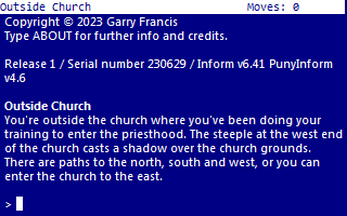
Search for the Lost Ark
Introduction
The stories about the Ark of the Covenant are well known, but its current location is a mystery. According to French author Louis Charpentier, the Ark was taken to the Chartres Cathedral by the Knights Templar, but no one outside the cathedral has ever seen it. There may be a good reason for this.
You were raised in a small village about 100 km from Chartres Cathedral. According to local legend, the Ark was secretly transferred from the cathedral to your village's church, where it would be safe from tourists and treasure hunters.
Prior to World War I, the Ark was hidden in the local forest so that it would be safe from the invading German army and it has remained there until this day.
The priest that hid the Ark recently passed away, taking the location of the Ark to his grave. The Church Council has decided that it's time to recover the Ark. As a seminarian (or trainee priest), they have asked you to return to your local village, use your local knowledge to find the Ark and return it to its rightful place on the altar in your church.
Instructions
This is a traditional text adventure that was written for ParserComp 2023, 30 April to 30 June 2023. See the jam page for the competition rules.
A text adventure is a form of computer game that presents you with a story. You take on the role of the main character in the story and control that character's actions. The story has a goal and you will need to solve puzzles in order to achieve that goal. The computer tells you where you are, what you can see and what's happening around you. You can then move around, examine the things you find and manipulate those things by telling the computer what to do using simple English commands.
Commands consist of a verb phrase, optionally followed by a noun phrase. Most commands can be abbreviated to a verb followed by a noun. For example, GET THE HOLY BIBLE can be abbreviated to GET BIBLE.
If the verb is followed by a preposition, this may alter its meaning. For example, GET LADDER will attempt to pick up the ladder, but GET ON LADDER will attempt to climb onto it.
In some cases, the verb phrase and first noun phrase may be followed by a second noun phrase. The two noun phrases are usually separated by a preposition. For example, HIT WALL will attempt to hit the wall with your hands (as you didn't specify a second noun phrase), but HIT WALL WITH HAMMER will attempt to hit the wall with the hammer. If you only use a verb and a noun, the game will generally tell you if it needs an extra phrase or implicitly try to deduce what is needed for the second phrase.
Don't panic! It's not as complicated as it sounds. Just use simple English sentences starting with a verb and it will all feel quite natural.
Movement
To move around, use commands like GO NORTH and GO SOUTH. You can move in any of the four cardinal compass directions, as well as UP and DOWN. To save typing, movement commands can be abbreviated to N, S, E, W, U and D. You can sometimes use other movement commands such as ENTER, EXIT, CLIMB, GET ON or GET OFF. These will be reasonably obvious when the time comes.
Examining things
Make sure you EXAMINE everything you come across, even insignificant things like scenery and objects mentioned in room descriptions, as subtle hints and clues are scattered everywhere. To save typing, EXAMINE can be abbreviated to X. For example, EXAMINE CHURCH can be abbreviated to X CHURCH.
You can also try your other senses when it seems appropriate, e.g. SMELL, TOUCH or LISTEN. Unlike EXAMINE, these actions aren't necessary to solve any puzzles, so don't feel obligated to use them.
Manipulating objects
Apart from examining things, most of your time will be spent manipulating objects. Use commands like GET or TAKE to pick up an object, e.g. GET CANDLE. Use commands like DROP or DISCARD to drop an object, e.g. DROP CANDLE. Use WEAR to wear something, e.g. WEAR CASSOCK. Use REMOVE to remove something that is already worn, e.g. REMOVE CASSOCK.
To see what you're currently carrying and wearing, use INVENTORY (or I). As you're not a pack horse, you can only carry ten items at a time, but you may be able to put things in containers if you need to increase your load.
There are many other verbs that can be used to manipulate objects. These will be fairly obvious when the time comes. Common verbs include OPEN, CLOSE, LOCK, UNLOCK, READ, DRINK, PUSH, PULL and so on. Use PUT, PLACE or INSERT to put objects into containers or on supporters, e.g. PUT CANDLE IN COFFIN or PLACE BIBLE ON LECTERN.
Communicating with characters
You will encounter a couple of characters in the game. When you first meet new characters, in addition to examining them, you should try talking to them, e.g. TALK TO FATHER. To get further information from them, try asking them about something relevant, e.g. ASK FATHER ABOUT ARK. You can also try showing them something or giving them something, e.g. GIVE CANDLE TO FATHER.
Advanced features
You can use IT or THEM to refer to the noun used in the previous command, e.g. GET BIBLE, EXAMINE IT, READ IT.
You can refer to multiple objects by separating the objects with AND, e.g. GET CANDLE AND BIBLE. Using IT and THEM in the next command will only refer to the last of those objects, e.g. EXAMINE IT will refer to the Bible.
You can use ALL to refer to all the appropriate objects with GET and DROP, e.g. GET ALL to get everything in the current location, GET ALL FROM ALTAR to get everything on the altar, DROP ALL to drop everything you're holding.
When using ALL, you can use EXCEPT or BUT to exclude some objects, e.g. DROP ALL EXCEPT CANDLE.
Finally, you can enter multiple commands on the same line by separating them with a period, e.g. UNLOCK DOOR. OPEN IT.
Scoring
There is no score in this game. Your objective is simply to find the Ark of the Covenant and return it to its rightful place on the altar in your local church.
Other commands
Use LOOK (or L) to refresh the display.
Use VERSION to get the game version. Use ABOUT or INFO to get background information and credits for the game. Use CREDITS to get the credits only.
Use SAVE to save your progress. Use RESTORE to restore a previously saved game.
Use UNDO to undo the last move. This is handy if you change your mind, get killed or make a mistake. You can only get killed if you do something silly. You should not be able to get into an unwinnable situation in this particular game. (UNDO is not available with the z3 version of the game.)
Use AGAIN (or G) to repeat the last command.
Use WAIT (or Z) to do nothing apart from pass the time.
Use HELP to get a brief reminder of how to play the game or HINT to get a context-sensitive hint related to the current location.
Use RESTART to restart the game from the beginning. Use QUIT (or Q) to quit without restarting.
Most importantly, have fun, enjoy the game and try to find the lost Ark of the Covenant.
Keyboard shortcuts
Some interpreters have keyboard shortcuts. If you are using an interpreter on a computer with a conventional keyboard, most will allow you to press the up and down arrow keys to cycle through your past commands. This is handy if you want to repeat the previous command or correct a typo.
Playing the game
There are two ways to play the game:
Click the Run game button (above) to play the game in a browser. If you use this option, QUIT will lock up the game. If this happens, just refresh the browser window.
Download the z5 file and play the game using a z-code interpreter (see below). A z3 file is also included, but this uses a feature that may cause some very old interpreters to crash.
Finding a z-code interpreter
There are a variety of z-code interpreters for all the major platforms, as well as many minor and retro platforms. There are far too many to list here. The best source of downloads is probably the Interactive Fiction Archive. Navigate to infocom/interpreters for z-code interpreters and interpreters-multi for interpreters that interpret both z-code games and other formats.
Common z-code interpreters
Android: I recommend Hunky Punk from Google Play. (There are others, as well.)
iOS: I recommend Frotz from the Apple App Store. (There are others, as well.)
Linux: See the links above.
Mac: See the links above.
Windows: I recommend Windows Frotz from the infocom/interpreters link above. (There are others, as well.)
Credits
Inform 6 compiler, language and library originally written by Graham Nelson and now maintained by David Griffith, David Kinder, Andrew Plotkin et al.
PunyInform library written by Johan Berntsson and Fredrik Ramsberg based on the Inform 6 library.
Parchment interpreter written by Dannii Willis et al.
Original concept by Jeff Smith.
Game design and coding by Garry Francis.
Play testing by Jade J Aincioa, John Ziegler, Larry Horsfield, Max Fog, Reiko Yukawa, Trenton Thompson and VanishingSky.
Cover image is from an engraved illustration in a Victorian book dated 1883 and no longer in copyright.
| Updated | 24 days ago |
| Status | Released |
| Platforms | HTML5, Windows, macOS, Linux, Android |
| Rating | Rated 2.0 out of 5 stars (1 total ratings) |
| Author | Garry Francis |
| Genre | Interactive Fiction |
| Tags | inform-6, Mystery, parser, punyinform, religious, Retro, text-adventure, Text based, Vampire |
| Average session | About an hour |
| Languages | English |
| Inputs | Keyboard |
Install instructions
See the game page for full instructions.



Comments
Log in with itch.io to leave a comment.
Is there much difference between the .z5 and the .z3? And since you have the .z3, do you have it written to an Apple II disk image?
There is no difference between the z3 and z5 story files, except that z3 does not support undo. I plan to do an Apple II disk image (and others) when I have the appropriate tool chain set up, but don't hold your breath waiting, as that requires a Linux computer, which I don't have.
Damn, mate, you are a war machine! How can you code this fast? I'll try the game out asap
I wrote the outline a few years ago and returned to it for this comp. I didn't keep any records, but it probably took a couple of months to write. I hope you like it.